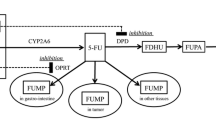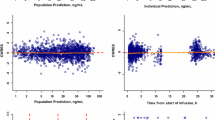Abstract
Purpose. The extremely low clearance and small distribution volumeof UCN-01 in humans could be partly due to the high degree of bindingto hAGP (1,2). The quantitative effects of hAGP on the pharmacokineticsof UCN-01 at several levels of hAGP and UCN-01 were estimatedin rats given an infusion of hAGP to mimic the clinical situation anda physiological model for analysis was developed.
Methods. The plasma concentrations of UCN-01 (72.5–7250 nmol/kgiv) in rats given an infusion of hAGP, 15 or 150 nmol/h/kg, weremeasured by HPLC. Pharmacokinetic analysis under conditionsassuming rapid equilibrium of protein binding and incorporating thedissociation rate was conducted.
Results. The Vdss and CLtot of UCN-01 (725 nmol/kg iv) in ratsgiven an infusion of hAGP, 150 nmol/h/kg, fell to about 1/250 and 1/700that in control rats. The Vdss and CLtot following 72.5–7250nmol/kg UCN-01 to rats given 150 nmol/h/kg hAGP were 63.9–688ml/kg and 3.18–32.9 ml/h/kg, respectively, indicating non-linearitydue to saturation of UCN-01 binding. The CLtot estimated by thephysiological model assuming rapid equilibrium of UCN-01 bindingto hAGP, was six times higher than the observed value while the CLtotestimated by the model incorporating koff, measured using DCC, wascomparable with the observed value.
Conclusions. These results suggest that the slow dissociation ofUCN-01 from hAGP limits its disposition and elimination.
Similar content being viewed by others
REFERENCES
E. Fuse, H. Tanii, N. Kurata, H. Kobayashi, Y. Shimada, T. Tamura, Y. Sasaki, Y. Tanigawara, R. D. Lush, D. Headlee, W. D. Figg, S. G. Arbuck, A. M. Senderowicz, E. A. Sausville, S. Akinaga, T. Kuwabara, and S. Kobayashi. Unpredicted clinical pharmacology of UCN-01 caused by specific binding to human α1-acid glycoprotein. Cancer Res. 58:3248–3253 (1998).
E. Fuse, H. Tanii, K. Takai, K. Asanome, N. Kurata, H. Kobayashi, T. Kuwabara, S. Kobayashi, and Y. Sugiyama. Altered pharmacokinetics of a novel anticancer drug, UCN-01 caused by specific high affinity binding to α1-acid glycoprotein in humans. Cancer Res. 59:1054–1060 (1999).
I. Takahashi, E. Kobayashi, K. Asano, M. Yoshida, and H. Nakano. UCN-01, a selective inhibitor of protein kinase C from Streptomyces. J. Antibiot. 40:1782–1784 (1987).
S. Akinaga, K. Gomi, M. Morimoto, T. Tamaoki, and M. Okabe. Antitumor activity of UCN-01, a selective inhibitor of protein kinase C, in murine and human tumor models. Cancer Res. 51:4888–4892 (1991).
C. M. Seynaeve, M. Stetler-Stevenson, S. Sebers, G. Kaur, E. A. Sausville, and P. J. Worland. Cell cycle arrest and inhibition by the protein kinase antagonist UCN-01 in human breast carcinoma cells. Cancer Res. 53:2081–2086 (1993).
S. Akinaga, K. Nomura, K. Gomi, and M. Okabe. Effect of UCN-01, a selective inhibitor of protein kinase C, on the cell-cycle distribution of human epidermoid carcinoma, A431 cells. Cancer Chemother. Pharmacol. 33:273–280 (1994).
K. Kawakami, H. Futami, J. Takahara, and K. Yamaguchi. UCN-01, 7-hydroxyl-staurosporine, inhibits kinase activity of cyclin-dependent kinases and reduces the phosphorylation of the retinoblastoma susceptibility gene product in A549 human lung cancer cell line. Biochem. Biophys. Res. Commun. 219:778–783 (1996).
T. Akiyama, T. Yoshida, T. Tsujita, M. Shimizu, T. Mizukami, M. Okabe, and S. Akinaga. G1 phase accumulation induced by UCN-01 is associated with dephosphorylation of Rb and CDK2 proteins as well as induction of CDK inhibitor p21/Cip/WAF1/ Sdi1 in p53-mutated human epidermoid carcinoma A431 cells. Cancer Res. 57:1495–1501 (1997).
S. Akinaga, K. Nomura, K. Gomi, and M. Okabe. Enhancement of antitumor activity of mitomycin C in vitro and in vivo by UCN-01, a selective inhibitor of protein kinase C. Cancer Chemother. Pharmacol. 32:183–189 (1993).
S. Akinaga, K. Nomura, K. Gomi, and M. Okabe. Synergistic antitumor effect of UCN-01, a protein kinase (C) inhibitor, combined with various anti-cancer agents. Proc. Am. Assoc. Cancer Res. 33:3072 (1992).
R. T. Bunch, and A. Eastman. Enhancement of cisplatin-induced cytotoxicity by 7-hydroxystaurosporine (UCN-01), a new G2-checkpoint inhibitor. Clin. Cancer Res. 2:791–797 (1996).
N. Kurata, T. Kuwabara, H. Tanii, E. Fuse, T. Akiyama, S. Akinaga, H. Kobayashi, K. Yamaguchi, and S. Kobayashi. Pharmacokinetics and pharmacodynamics of a novel protein kinase inhibitor, UCN-01. Cancer Chemother. Pharmacol. 44:12–18 (1999).
J. M. H. Kremer, J. Wilting, and L. H. M. Janssen. Drug binding to human alpha-1-acid glycoprotein in health and disease. Pharmacol. Rev. 40:1–47 (1988).
G. R. Wilkinson. Plasma and tissue binding considerations in drug disposition. Drug Metab. Rev. 14:427–465 (1983).
N. Kurata, T. Kuramitsu, H. Tanii, E. Fuse, T. Kuwabara, H. Kobayashi, and S. Kobayashi. Development of a highly sensitive high-performance liquid chromatographic method for measuring an anticancer drug, UCN-01 in human plasma or urine. J. Chromatogr. B 708:223–227 (1998).
M. Gibaldi and D. Perrier. Noncompartment analysis based on statistical moment theory. In M. Gibaldi, and D. Perrier (eds.), Pharmacokinetics, Marcel Dekker, New York, 1982, pp. 409–417.
N. Watari, and L. Z. Benet. Determinant of mean input time, mean residence time, and steady-state volume of distribution with multiple drug inputs. J. Pharmacokin. Biopharm. 17:593–599 (1989).
K. S. Pang, and M. Rawland. Hepatic clearance of drugs. I. Theoretical considerations of “well-stirred” model and a “parallel tube” model. Influence of hepatic blood flow, plasma and blood cell binding, and the hepatocellular enzymatic activity on hepatic drug clearance. J. Pharmacokin. Biopharm. 5:625–653 (1977).
B. Davies, and T. Morris. Physiological parameters in laboratory animals and humans. Pharm. Res. 10:1093–1095 (1993).
T. Fujita, and A. Koshiro. Development of the convenient and direct numerical analytical method of the pharmacokinetics of phenytoin by an ordinary and/or the Bayesian weighted least-squares method using the program MULTI2 (BAYES). J. Pharmacobio-Dyn. 12:717–725 (1989).
K. Yamaoka, and T. Nakagawa. A nonlinear least squares program based on differential equations, MULTI (RUNGE), for microcomputers. J. Pharmacobio-Dyn. 6:595–606 (1983).
E. Fuse, T. Kobayashi, M. Inaba, and Y. Sugiyama. Prediction of the maximal tolerated dose (MTD) and therapeutic effect of anticancer drugs in humans: integration of pharmacokinetics with pharmacodynamics and toxicodynamics. Cancer Treat. Rev. 21:133–157 (1995).
Author information
Authors and Affiliations
Rights and permissions
About this article
Cite this article
Fuse, E., Hashimoto, A., Sato, N. et al. Physiological Modeling of Altered Pharmacokinetics of a Novel Anticancer Drug, UCN-01 (7-Hydroxystaurosporine), Caused by Slow Dissociation of UCN-01 from Human α1-Acid Glycoprotein. Pharm Res 17, 553–564 (2000). https://doi.org/10.1023/A:1007512832006
Issue Date:
DOI: https://doi.org/10.1023/A:1007512832006




